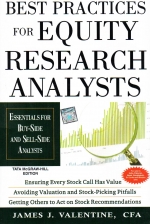Tab Article
Most equity research analysts learn their trade on the job by apprenticing under a senior analyst. However, equity analysts who work for senior producers often have little time or incentive to train new hires, and those who do have the time may not have research skills worth emulating.
Now, Best Practices for Equity Research Analysts offers promising equity research analysts a practical curriculum for mastering their profession. James J. Valentine, a former Morgan Stanley analyst, explains everything today's competitive analyst needs to know, providing practical training materials for buyand sell-side research analysis in the United States and globally.
Conveniently organized for use as a learning tool and everyday reference on the job, Best Practices for Equity Research Analysts covers the five primary areas of the equity research analyst's role:
- Identifying and monitoring critical factors
- Creating and updating financial forecasts
- Deriving price targets or a range of targets
- Making stock recommendations
- Communicating stock ideas
Expanding upon material covered in undergraduate courses but written specifically to help you perform in the real world, this authoritative book gives you access to the wisdom and expertise of leading professionals in the field. You'll learn best practices for setting up an information hub, influencing others, identifying the critical factors and information sources for better forecasting, creating a better set of financial forecast scenarios, improving valuation and stock-picking techniques, communicating your message effectively, making ethical decisions, and more.
Without Best Practices for Equity Research Analysts, you're just treading water in the sink-or-swim world of the equity analyst.


